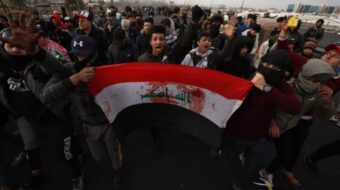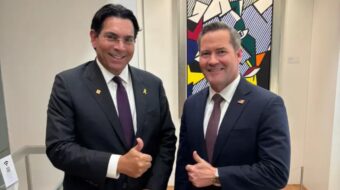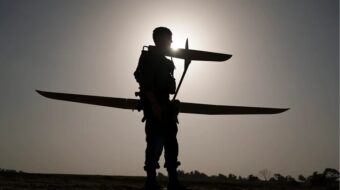
Western-backed regimes in the Middle East — namely Israel and Saudi Arabia — have long viewed the Islamic Republic of Iran as an existential threat.
This is based on the support of the Iranian regime for the Hezbollah and Hamas factions in Lebanon and Gaza, both of which are regarded as a threat by Israel.
The Islamic Republic also repudiates the particular brand of Sunni Islam perpetrated by Saudi Arabia, favoring a militant interpretation of Shia Islam which it seeks to roll out across the region.
In this regard the 1979 revolution in Iran, as subsequently hijacked from the people by the theocracy, was a game changer in the latter part of the 20th century.
The revolutionary momentum in Iran came not from a desire on the part of the people to see an Islamic state established but to see an end to the tyranny of the Pahlavi dynasty, in the form of the Shah, an obstacle to progressive democratic change and a puppet of the West.
That the desire of the people for peace, democracy, and social justice was thwarted by a theocratic junta continues to be an abiding tragedy for the people of Iran and the world.
However, over the 40 years or more of its dictatorship, cracks in the edifice of the Islamic theocracy in Iran have shown.
Although a highly controlled process, the presidential elections have occasionally resulted in outcomes which have delivered presidents with a slightly more reformist outlook, albeit within the confines of the strictures of the Islamic Republic.
The stolen 2009 election, which saw the return, for a second term, of populist Islamist Mahmoud Ahmadinejad, resulted in widespread protest on the streets of Iranian cities and gave birth to the so-called Green Movement, which demanded reform within the Iranian political system.
Mir Hossein Mousavi, the popular candidate who on all accounts had been considered the winner, refused to accept the result and the mass protest of millions overwhelmed Iran for almost eight months. Mousavi, an architect by trade, has lived under house arrest till now.
On Sunday, Mousavi called for a peaceful political transition from the current Islamic Republic to a democratic secular model based on the continued and legitimate demands of the people of Iran.
Equally important have been the wave of strikes and protests which have been engulfing the country since 2017, as workers demand improvements in pay and conditions, along with meaningful trade union recognition.
There were mass uprisings in January 2018 and November 2019, and again last year, with various important economic triggers, for example, the three-fold increase in the price of fuel.
There have been labor strikes, teachers’ strikes, as well as numerous protest rallies held by pensioners, nurses, and others.
Therefore, the factors behind the current uprising were already present and waiting for the spark which would ignite the fire.
That spark came with the news of Mahsa Amini’s killing on September 16, 2022.
It is clear that street protests were a feature of Iranian life long before the murder in custody of Amini but have intensified since then. The momentum has the potential to pose a real existential threat to the Islamic regime.
The latest statistics from human rights organizations estimate that at least 500 people, including 70 minors, are known to have been killed.
Hundreds more have been injured and maimed during the current wave of unrest. More than 20,000 people have been arrested in connection with the protests during the same period.
The Iranian government has recently announced a pardon for those involved in the protests. However, those who are deemed to qualify for a pardon are expected to admit that they were wrong to engage in protest action and commit to not engaging in such action in the future.
So far, four of the detained protesters have been executed, in December and early January. More than 100 other detainees have been sentenced to death and are at imminent risk of execution.
Fortunately, in the last five weeks, none of the detained protesters are reported to have been executed.
This is mainly due to the international outcry that followed the last executions, along with protests and appeals from around the world for a halt to the other death sentences being carried out.
It is clear that the Islamic Republic dictatorship is feeling the heat and pressure in this respect, at least for now.
The executions follow a tragically familiar pattern in Iran where the accused have no access to lawyers or family members and are subject to horrific beatings and torture throughout their detention.
“Confessions,” which are then publicly broadcasted via regime media, are routinely extracted through torture and have no real evidential value.
Instability inside Iran is attracting significant external interest as the enemies of the regime begin to mobilize in anticipation of its collapse.
On the one hand, there is the increasing threat of military intervention from Israel.
At the end of January, an Iranian military installation in Isfahan came under drone attack.
Reports of the impact of the attack are conflicting. Iranian state media claim that the drones were destroyed, with limited impact on the complex at Isfahan.
The Wall Street Journal describes the attack as “the work of Israel,” while the Jerusalem Post suggests that the drone strike had been a “tremendous success.”
Whatever the truth of these reports, there is consensus that an attack took place, an indication that the scope for foreign intervention in Iran is being tested, the consequences of which could lead to wider conflagration in the region.
Just days before the drone attack, Israeli President Isaac Herzog had called for NATO to confront “Iranian threats” and urged member countries to toughen their approach against the Iranian regime.
According to Euronews, after meeting NATO secretary-general Jens Stoltenberg Herzog stated: “The illusion of distance does not stand any more.
“NATO should take the strongest possible stance against the Iranian regime in the form of imposing economic, legal, and political sanctions, as well as adopting a credible approach to militarily deterring this regime.”
Also circling are supporters of monarchy, endorsing exiled Reza Pahlavi, son of Mohammad Reza Pahlavi, the last Shah of Iran, suggesting that a monarchy could be the way to “lead a transition” when the Islamic Republic falls.
While there is no evidence for popular support for a return to a monarchy within Iran, there is every possibility that a dictatorship compliant with Western interests may be deemed an option, if foreign intervention is stepped up to accelerate regime change.
The demands of the current popular protests are for peace, democracy, and social justice. Neither foreign intervention, monarchy, or a combination of both, will deliver these demands for the Iranian people.
The drone attacks on the military complex in Isfahan must be condemned, as such dangerous military adventures pose a threat to the Iranian people, the Middle East, and the Persian Gulf region.
The Committee for the Defense of Iranian People’s Rights (CoDIR) calls upon all progressive and freedom-advocating forces in the region and around the world to raise their voices in protest against these policies.
The genuine protests and demands of the Iranian people must be supported and the future of Iran must be entirely in their hands.










